Now Reading: Top 10 Best Places to Visit in Aurangabad for History, Culture & Nature
-
01
Top 10 Best Places to Visit in Aurangabad for History, Culture & Nature

Top 10 Best Places to Visit in Aurangabad for History, Culture & Nature
1. Sarola Forest Tourism- Per Mahismal

Sarola operates as a forest tourism destination in Aurangabad district which stands at 1000 m above sea level and distances itself 24 km from the city center. The destination maintains its cool air status due to its elevated altitude. Sarola provides Aurangabad residents with a superb day trip destination because it rests among mountains while being engulfed by forests. The destination holds less popularity than Mahismal. The development at this site initiated in 2008.
What to see
Visitors can enjoy scenic views through two viewpoints which the forest department established at Sarola. The front location holds the position of first view point. Visitors can find a rest house at the very end of this viewpoint which spans 45 meters long. A climbing path leads behind the temple to the cliff without utilizing the vehicle road. The view point offers visitors an amazing panorama that combines Sarola mountain and its surrounding mountain sceneries and valley landscapes of this Sarola village. The Forest Department established the Tumdar Pagoda at this location. The lower forest near this spot offers an opportunity to listen to peacock songs if you wait patiently.
Tourists do not utilize the vehicular path at this second viewpoint since the path remains unused. The path to the second ridge involves descending from one ridge before ascending back up through dense bush areas. The continuous stretch of plateau becomes visible after passing through dense bushes while ascending the trail. An observation tower stands in this location because of the forest department’s presence. One can observe a complete view of the plateau region from this spot. You can experience two sightlines from this point of view between the plateau beautiful view and the reverse hill of Sarola which looks toward Aurangabad cityuraa Harsul Lake offers a magnificent view which lies towards the direction of Aurangabad city. A gray image of Aurangabad spread east west. The clear atmosphere allows viewers to spot the Doordarshan transmission tower in Hudko along with the newly built Chikhalthana airport. During historical times people in the center of the flat mountain terrain would need protection to ensure the safety of Aurangabad city.
The Ganapati temple bears a small size at the bottom of the cliff. This holy site contains two architectural features including a stone tank beside its temple. The temple followers state that drinking water emerging from beneath the ground is perfect. Without any certain records we can only assume that the ancient water reservoir was created in the distant past.
The source of a lovely stream can be spotted by descending slightly from the dense vegetation. The stream remains wet only during heavy rainfall periods but dries up at other times. Accessing the vehicle directly requires walking downward from the stream until you reach the established path. During the trip you will encounter the shrine of an unknown devotee.
way to go
From Aurangabad you will find a small ford which leads to the International Buddhist School. On the right-hand side rests the Sarola indicating board of the forest department. Turning off from this road brings you straight to the Sarola village. The site requires a personal vehicle to access it when visiting. Accessibility through public transport remains unavailable since there are no people traveling on the roads. A player in excellent condition should be utilized in Ghatmatha area because of the narrow road and decreasing population density.
Distance
Around 24 KM (from CIDCO Bus Stand in Aurangabad City)
2. Antur Fort
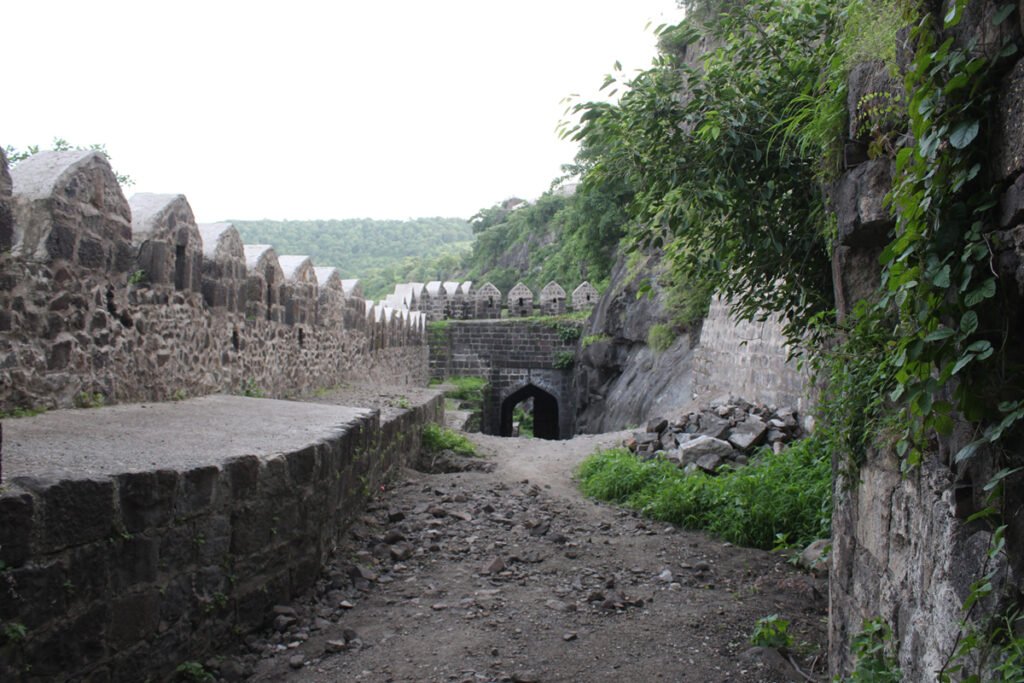
Anturgarh Thana stands strategically positioned in between east-west directions of the Ajantha-Satmala Sahyadri range. The location rests within Kannad Taluka of Aurangabad District. As a protected monument of the Department of Archeology the fort stands under the supervision of Government of Maharashtra.
Places to see in the fort
A magnificent southern-facing gate exists inside the eastern side cliff hollow at Antur. The gate stands in such a slim opening that only those who approach it directly can observe it. Guard posts exist outside the gate entrance. The gate used to have wooden barriers until 1990 but the doors disappeared a few years back. The interior pathway exists within fort walls which remain narrow until today. The pathway is covered with numerous stones that block the way. The front gatr, however, faces the east direction. This is a grand gate. The third gate exists after crossing the second gate. Several sculptures decorate the interior wall of the second gate arch. One can find similar sculptural designs throughout various locations. The sculpture at this setting uses four cannon balls alongside its decoration scheme. The decoration method of this meditation spot exists exclusively in Maharashtra state and its surrounding areas. We would observe the Farsi inscription on the third gate after which we could enter the fort by witnessing this distinctive wall decoration. The entry occurs in the middle part of the fort.
This fort extends toward the south-east direction with surrounding fortification structures. The north segment of this embankment contains defensive structures which can be reached when you walk toward its northern areas. The hill exists to the left side and opposite the hill sits a giant lake. A magnificent structure stands at the hill slope. People can access the building roof through its designated steps. There are steps for that. A large square exists on top of the hill where people access the teahouse through steps located in the northern sector. From this square surveillance is possible across the entire fort while witnesses become available of Anjatha-Satmala range and Khandesh north region. The southern area of the fort stands separate from the other sections by means of a protective wall. The fort contains three main gates as entrances for visitors. On this fort there exists both a main central gate and two elevated defense towers located on the south side. A water reservoir was sculpted into the western slope of middle hill along the fortification. A platfort construction enhances the strength of the northern section of the fort. This side of the fort contains an enormous boat-shaped carving because the mountain range forms a strong connection to it. A protective security structure exists on top of the trench along with defensive armor on it. There is a cannon lying here.
History
One of the most powerful and strong structures built by a Maratha chieftain exists today. The fort eventually passed to the authority of Ahmadnagar Nizamshahi after its former ruler. The term of Malik Ambar brought about construction activities at this site. This fort subsequently passed to Mughal control during the Mogli storm. British forces took control of this fortification as well as several other defenses.
3. Gautala Outram Ghat Sanctuary
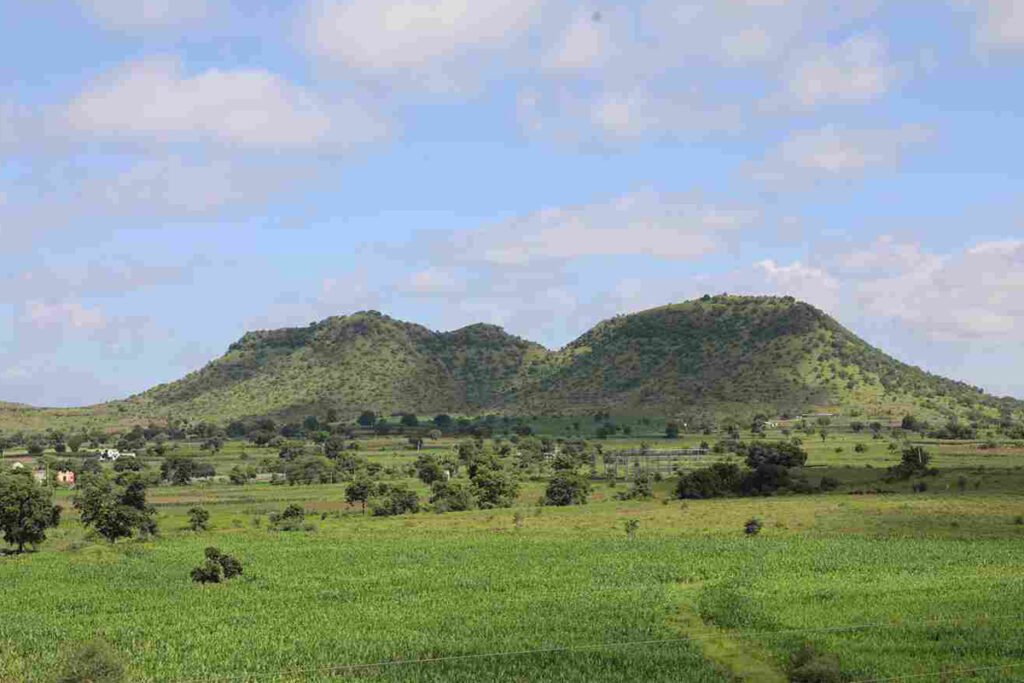
The Gautala Sanctuary exists in two parts which cover a combined area of 260 Sq. that I. territory between Chalisgaon Taluka of Jalgaon District and Kannad Taluka of Aurangabad District.
Establishment
Gautala Sanctuary was established in 1986. The sanctuary exists in Kannad taluka of Aurangabad district covering an area of 260 square kilometers. The forest area of 17 villages in Kannad taluka makes up this sanctuary.
Location
The sanctuary rests at fifteen kilometers distance from Kannad village alongside twenty kilometers distance from Chalisgaon village. Kannad village stands at a 60-kilometer distance from Aurangabad. The route from this spot continues its journey towards Chalisgaon. After 2 km from Kannad, a fissure breaks. The direct entry to Gautala Sanctuary becomes available by traveling through this opening. One obtains entry at this location by registering at the checkpoint and paying the specified fees. Visitors can access the sanctuary either by using their vehicles or walking in.
History
Multiple forms of vegetation can be observed after passing through the Kannad entrance. From further into the path one encounters Chandan Nala which runs through a sandalwood forest. Various colorful birds including parrots and peacocks can be observed as they sit on the riverbank. The same region contains a diverse selection of Satbhai, Sugran, Dayal, Bulbul, Kotwal and Chandol birds. After crossing the stream the area develops into a thick forest. Next is a temple of Maruti. Gautala Lake lies in front of the temple. The entire surface of this lake consists of grass growth. This area used to be inhabited by herdsmen living there with their grazing cattle. A group of herdsmen utilized to allow their cattle to feed from this area. The lake received its name Gautala which later became the sanctuary name after its establishment.
About
The Gautala pond receives its water supply from trees like bamboo and ranashevaga, ranpimpal, kadulimb, palas with tamarind among them. A wide range of birds like divers and waterfowl and others can be observed in the pond. A tower for observability stands nearby the pond. The observation tower located at this position lets visitors see the complete scene of Gautala area.
Source of the river
This mountain produces the Nagad river which can be observed from the left side of Gautala lake. The watercourse descends into the valley located on the right side of its path. Natural water accumulates at Nagad Lake by utilizing the local river. One can observe Manjarmal hill extending beyond Satmalaya in a particular direction. The summer season causes dryness in all forest water bodies yet Nagad lake together with Garada and Nirbhor water bodies maintain their waters. Wild animals visit the area to satisfy their thirst during hot summer months.
4. Aurangabad Caves
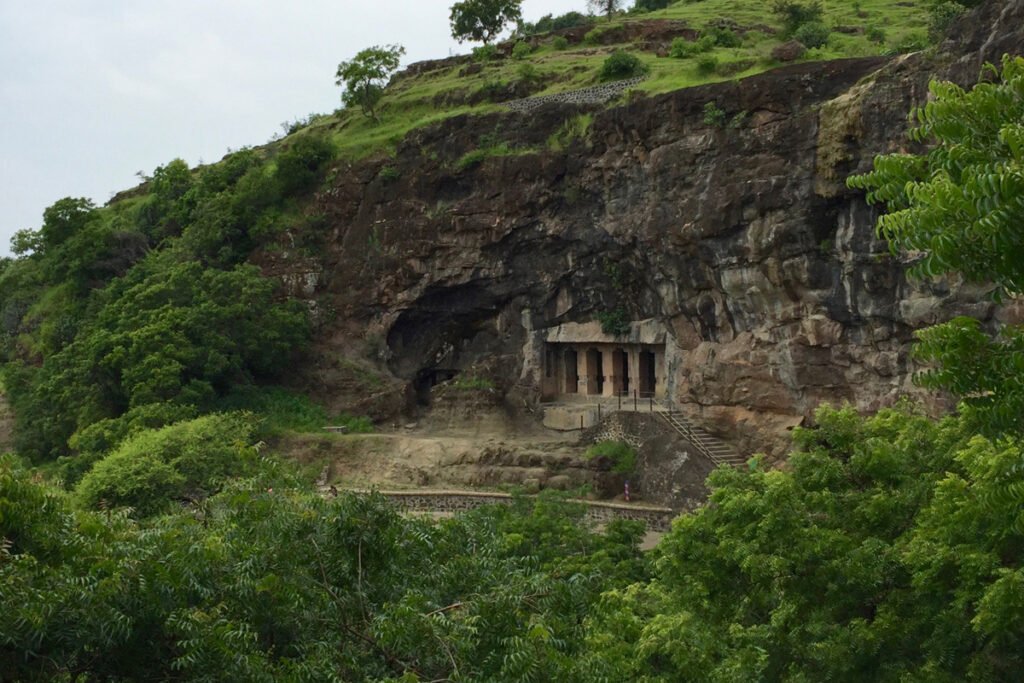
The Aurangabad Caves exist roughly two kilometers toward the north from Bibi Ka Tomb in Aurangabad city. These Buddhist caves were hollowed out from the mountainside under the direction of the Buddhist faith. An initial mention of this place as a Buddhist location emerges in the expansive Kanheri chaitya. The builders constructed this cave stretch from the 6th century AD to the 7th century AD. It has 12 caves.
The 12 caves of Aurangabad originate from soft basalt rock creating groups of three sections according to their locations. The caves exist in connection with those located at Ajantha and Verul which are in the proximity of Aurangabad. Ajanta Caves together with Verul Caves received World Heritage Site status from UNESCO.
Among the 12 caves of the area Cave No. 3 follows the architectural style of Mahayana Ajanta caves. Among these caves Cave No. 7 assumes a resemblance to Rameshwar Cave (Cave No. 24) that exists in Verul. From the entrance veranda visitors reach the sacred chamber which stands at the back wall. The sanctum sanctorum has rooms for the monks which are located within its circular promenade. The group of Buddha caves demonstrates significant historical milestones from Indian history.
ine kilometers separate Aurangabad Caves from central Aurangabad city while the present Dr. Babasaheb Ambedkar Marathwada University together with Bibi Ka Tomb sit a few kilometers away. The sculptured artworks in these caves exist as smaller deteriorated pieces which receive fewer visitors than the Ajanta and Verul locations. The time-spatial sentient existence becomes apparent when one observes this cave. A protected monument stands as recognized heritage by the Archaeological Survey of India at this site.
ave No.1 and No.3 of Aurangabad Caves match some aspects with the final cave at Ajantha. The twentieth-century scholars refer to these sites as the connection between Ajanta-Verul caves. Historians together with scholars agree that the third cave predated the first cave chronologically. The weaving patterns in the third cave appear well-arranged with decorative elements. The third cave displays the best geometric structure with its highest accuracy levels.
5. Kailas Temple, Ellora
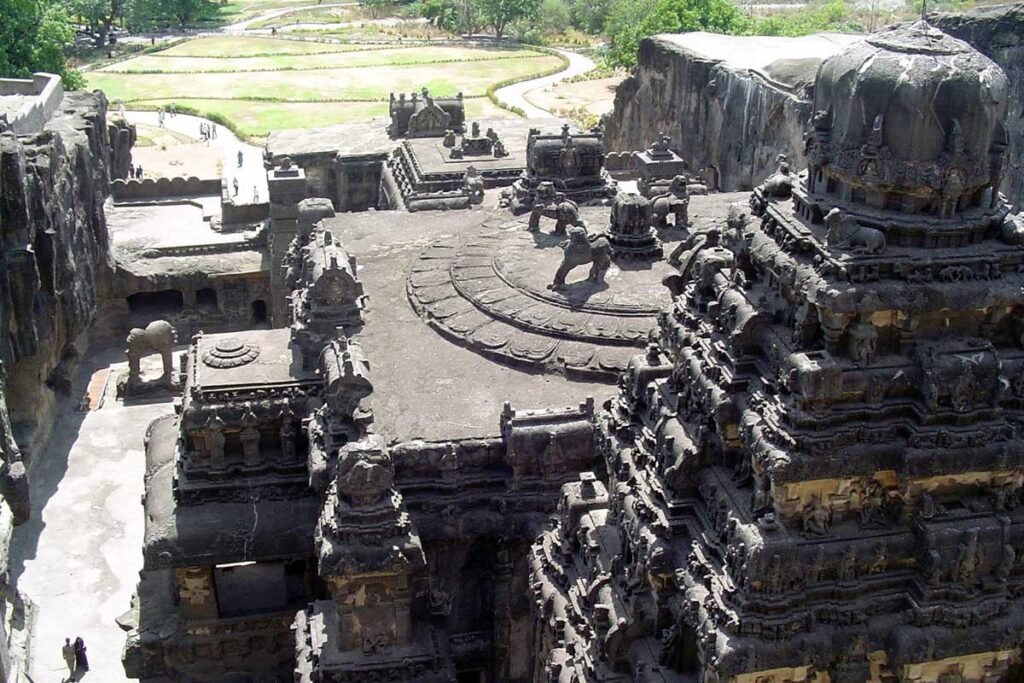
Located on the Sahyadri Hills near Aurangabad in Maharashtra stands the Kailashnath Temple or Kailash at Ellora Caves which holds the title as the largest rock-cut Hindu temple in the world. Amongst the 100 available caves thirty-four are accessible to visitors while cave number 16 stands as the expansive Kailasa Temple which comprises part of the UNESCO World Heritage Site and represents among the largest uncut stone excavations worldwide. The temple stands as an exclusive architectural masterpiece and historical marvel because it was excavated vertically through one continuous basalt rock on Charandri hills. Experts regard the Kailasa temple as a near duplicate of the Virupaksha temple located in Karnataka.
The historical records indicate that Rashtrakuta king Krishna I between 756 and 773 AD built the temple with Pallava and Chalukya kingdom artists during the 8th century. The Virupaksha temple model which he already possessed allowed the king to construct this enormous Kailasa temple in a shorter period of time. His construction of a temple complex in multiple stories after Mount Kailash gives Kailash Temple its popular name.
The temple construction required over a century according to current experts but it actually finished within a span of eighteen years.
A U-shaped courtyard extends 82*46 meters from the base while reaching 150 feet deep facing two sets of divine voices where Saiva sect deities stand on the left and Vaishnava sect deities stand on the right just past the two-storied entrance. The main Shiva temple along with Nandi features a flat-roofed pavilion which rests upon 16 pillars. Each section within the temple structure shares Vedic narratives together with Mahabharata and Ramayana histories through its detailed reliefs and sculptures. Among the most well-known sculptures at the temple visitors can see Ravana trying to carry Mount Kailash together with scenes of Lord Shiva as an ascetic and Shiva as Nataraja and Shiva and Parvati playing dice as well as Varaha raising the earth and Goddess Durga slaying the demon Mahishasura and several more figures including elephants and lions making tall dough. The temple’s main floor features the Rashtrakuta which represents both power along with great fortune happening to them. The temple premises maintains five primary shrines that honor Ganga, Yamuna and Saraswati among other sacred rivers. The courtyard contains two flagpoles as well. Brief about Ellora Caves, UNESCO World Heritage Site, Maharashtra, India.
Thirty-four cave temples near the small village of Verul or Ellora can be found in Aurangabad district’s Maharashtra state and have earned the status of Ellora Caves worldwide. The Archaeological Survey of India protects this historical site while UNESCO named it as a World Heritage Site during 1983. The Charanendri Hills contained the world’s biggest and largest rock-cut architectural complex of temples. A total of 100 caves establish this campus where visitors can access 34 of them. Ajanta Caves together with Ellora Caves are referred to as Ajanta Ellora Caves due to their closeness at just 100 km apart. This site showcases all three major religious communities of Hinduism Buddhism and Jainism within the same campus thus illustrating ancient India’s acceptance of diversity. During the era spanning from 600 to 1000 AD, the site included Buddhist together with Jain and Hindu temples and religious objects. The Kailasa temple’s monument in Cave No. 16A stands out as the most significant among all because of its chariot appearance to worship Shiva. The Kailasa temple stands as the largest stone excavation in the entire world. Scientists excavating the Kailasa temple discovered religious sculptures and folk tale representations which were carved into Vaishnava, Shakta, and their abbreviated principal Hindu elements in relief panel forms.
The best period to see the site extends across the entire year.
The destination is located at Kailas Temple in Ellora Caves near Verul Aurangabad Maharashtra.
Every cave in this complex must be visited to experience the ancient Indian architecture.
The visiting hours to Kailas Temple, Ellora Caves operate on a schedule from General 7am until 6pm with the exception of Tuesday which is a closed day.
The Kailas Temple operates from 7:00 am till 6:00 pm except for Tuesdays when it remains closed.
6. Siddhartha Garden and Zoo
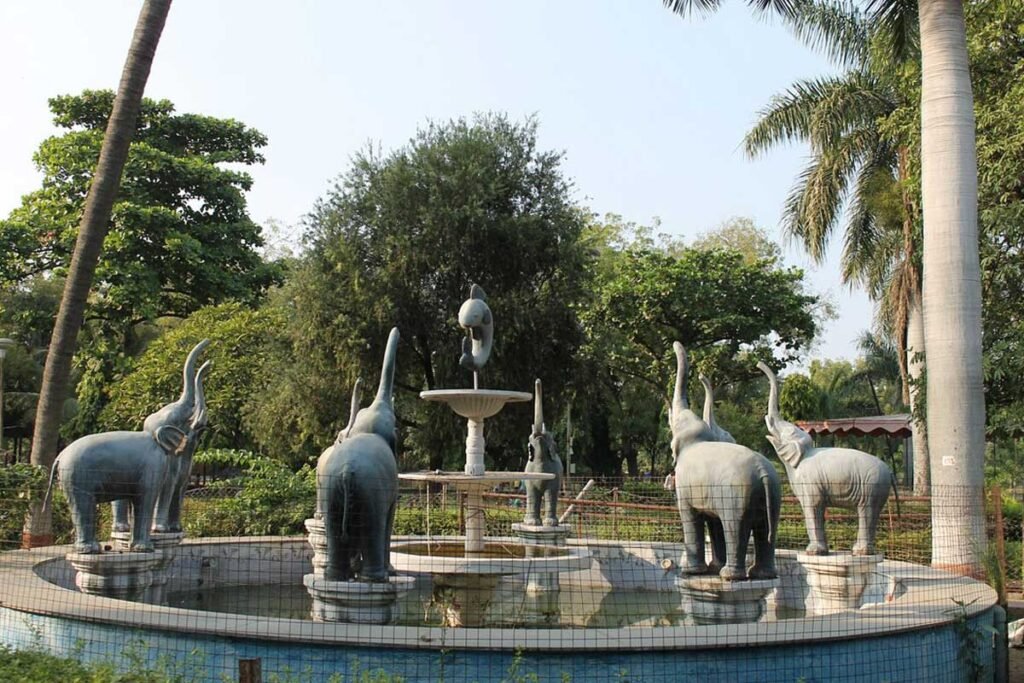
People of all ages may find pleasure in visiting Siddharth Garden and Zoo which functions as a major tourist destination in Aurangabad. Siddharth Garden is a favored weekend getaway for residents because it includes a landscaped space with flowering vegetative collections and aquatic facilities alongside a typical zoo exhibition.
Visitors can relax peacefully in the spacious garden while observing various exotic zoo animals present such as tigers together with elephants and crocodiles and snakes. This park along with its zoo serves as a suitable destination for educational wildlife experience and pleasant family reunions.
The park rests 3 kilometers from Aurangabad Railway Station while remaining 4 kilometers from Bibi Ka Maqbara at Samarth Nagar section of Aurangabad city. Siddharth Garden has earned its status as a major picnic destination among Aurangabad residents who visit this spot in high numbers during evening hours on both weekend and weekdays.
The expansive landscaped garden of Siddharth Garden shows its green character across its extensive ground. The park divides into two spaces where visitors can enjoy both a zoological setting and grassy open area. Siddhartha Garden Zoo stands as the primary attraction within this site which combines an aquarium and several other attractions including a zoo. Visitors can see various wild animals living in the zoo at its tiger, lion, leopard, civet cat, snake house, crocodile, emu, fox, deer, hyena and other animal enclosures. The visit was very enjoyable to everyone present. The park features both a musical fountain together with a Buddha statue as major attractions.
Venue: Central Bus Stand Road, Mhada, Aurangabad
Time: 9 AM to 7 PM
Entrance Fee: Garden: Rs 20 per person; Zoo – Rs.50 per person
7. Salim Ali Sarovar
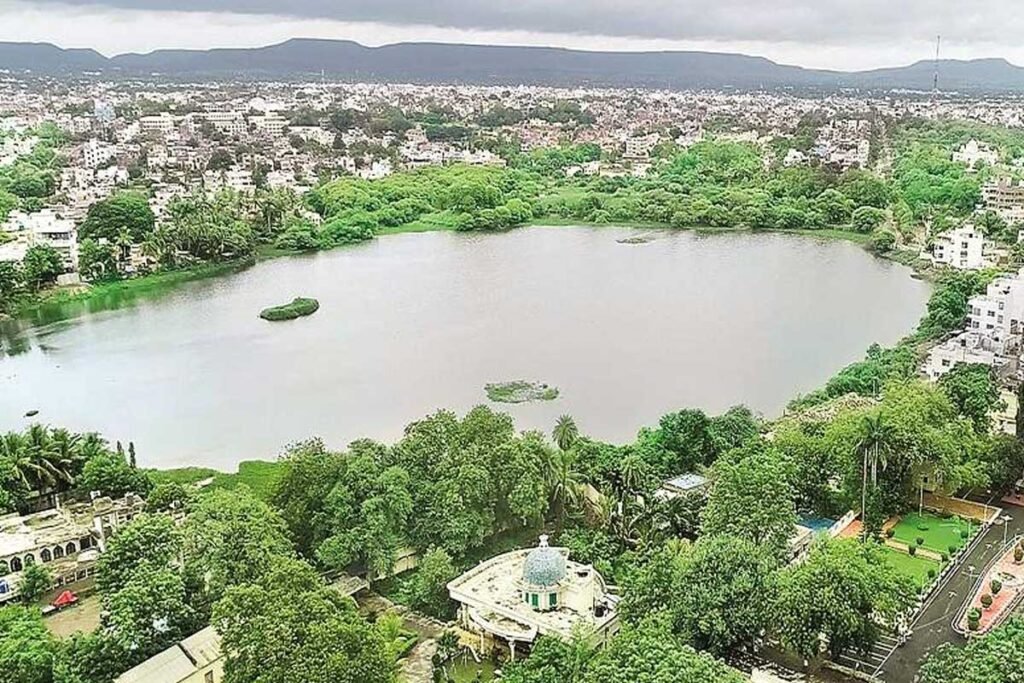
Visitors seeking peaceful environments with natural landscapes can find the best tourist spot in Aurangabad at Salim Ali Lake. Nature lovers find this large lake with its surrounds of vegetation to be a perfect retreat because it emits a quiet serenity that plays peaceful natural sounds without interruption.
The extensive bird sanctuary located around the lake attracts multiple bird watchers because many different species exist there. Visitors who wish to enjoy the lake scenery or take photographs should definitely come to this site.
The Salim Ali Sarovar (Marathi – Pakshimitra Salim Ali Sarovar) rests in front of Himayat Bagh which stands as one of many gates within Aurangabad close to Delhi Gate. The complex exists in the northern section of the urban area. This reservoir appeared under the Mughal era with the name Khiziri Talab. Salim Ali received his name from the renowned ornithologist and naturalist and people refer to it as the national bird of India. Both the Divisional Commissioner Office Aurangabad Division and Collectorate of Aurangabad District are situated in the vicinity.
The entire northern wall from Salim Ali Lake through to Begampura Mausoleum featured a big marsh under Aurangzeb until he ordered its removal in front of his palace because of health problems due to excessive dampness. Ordered the part. The land known as Kila-e-Ark ought to become a farming territory after it undergoes filling operations. The officer of Aurangzeb’s court converted this recovered land into a Mughal garden (presently known as Himayat Bagh) which featured diverse fruit tree varieties for the royal court personnel. The remaining section of the water reserve extended to the area beyond Delhi Gate where Khijri lake stands. An enclosed boundary surrounded the Kanwal Lake, which also had a local name of Loti. This small freshwater reservoir existed near Aam Khas Maidan between Qila-e-Ark and Begampura and received water from a spring before being intentionally destroyed for flood prevention.
The present-day Salim Ali Talab possesses both a tiny bird sanctuary together with suitable Christmas bird-watching opportunities from migratory birds during winter. The Aurangabad Municipal Corporation acts as the entity responsible for park upkeep. The boating service operates during monsoons and winters when sufficient water fulfills the lake. A dredging operation occurred in the recent past to enhance its water storage capabilities.
At Salim Ali Lake and its surrounding area exists a city-deserted rich biodiversity site which contains about 16 tree species including 11 shrubs and 8 climbers with 32 herbaceous terrestrial plants and 10 types of algae but also 12 aquatic plants together with 16 aquatic insects and insects. Crustaceans, nine types of fish, 15 types of reptiles, seven types of rodents and mammals and 102 types of insects. Environmental activists and bird enthusiasts in the city strive to save Salim Ali Lake as a vital biodiversity location by restricting access from the public.
Place : Chhatrapati Nagar, Aurangabad
Time : 8 AM to 5 PM
Entry Fee: Free Entry
8. Ajanta Caves
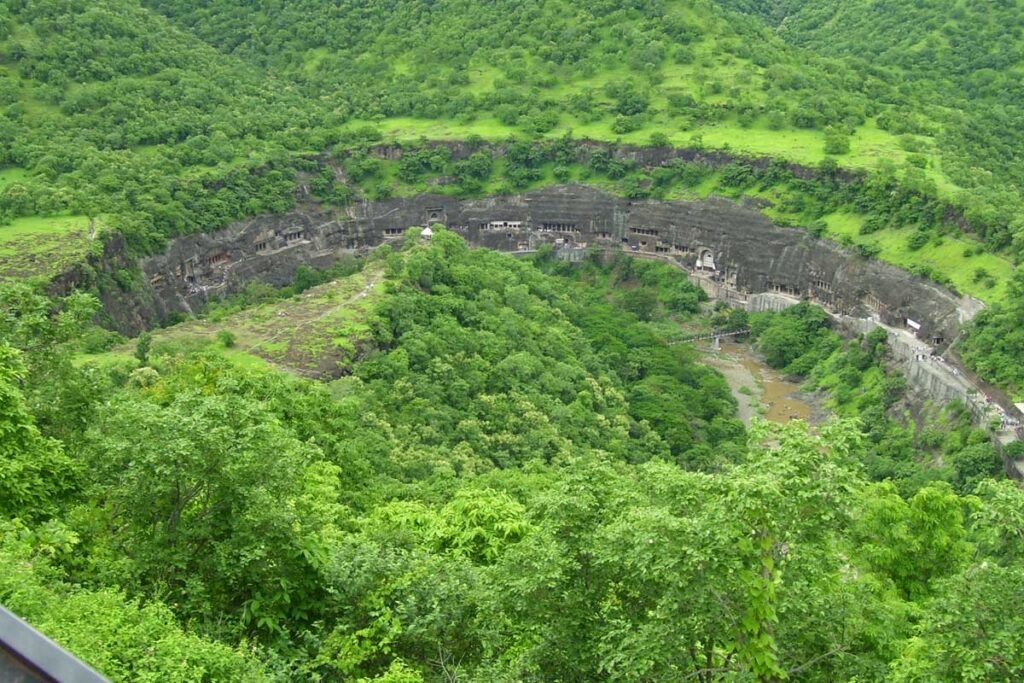
Aurangabad residents usually begin their attraction search with the name Ajanta Caves in mind. These Buddhist caves representing ancient architecture and Indian art masterpiece were carved into rocks around 2nd century AD and comprise 30 temples.
All of the Ajanta Caves functioned as different facilities within this UNESCO World Heritage Site. The architectural elements and geometric factors of these caves indicate that ancient Buddhist monks lived in these caves to practice Buddhism and study their faith and to pray. The wall murals together with paintings and carvings give us access to major previously unknown aspects of past living styles and cultural methods and traditional customs.
A group of historic Buddhist caves exists near Ajintha village in Aurangabad district at 98 km distances from both Aurangabad and Ellora Caves, 202 km near Shirdi, 272 km near Nashik, 326 km near Pune and 443 km near Mumbai. Maharashtra. Ajanta Caves rank among the first buildings to earn recognition as a UNESCO World Heritage Site in India. Bringing them under the protection management of the Archaeological Survey of India ensured their preservation.
Ajanta Caves occupy the place as both India’s foremost historical monument and among the essential heritage destinations near Aurangabad. Construction on the caves started in 2nd century BC before ending in 6th century AD. Two construction periods existed for the caves: the initial group originated in B.C. during the 2nd century and the subsequent set was constructed from the 4th to the 6th centuries.
The Ajanta Caves were carved out of a horseshoe-shaped rocks that tower 76 meters above the Waghur River. Monks resorted to these caves for nearly nine centuries before leaving them behind after construction with basic tools of hammer and chisel. A military officer from the Madras regiment of British Army revealed the caves during his 1819 hunting expedition. Following the announcement of the discovery the Ajanta Caves received immense popularity so tourists began flocking to this site in India.
The complex contains 29 stone cave monuments that were constructed across two different historical times when one section originated from the Satavahana period and the other part developed during the Vakataka period. Five stone caves including Caves 9, 10, 12, 13 and 15A were constructed during the first phase of the Satavahana dynasty while being part of Hinayana Buddhist traditions. The complex features sixteen stone cave monuments which were built in two periods. Caves 9 and 10 serve as Chaityagrihas while Caves 12, 13 and 15A operate as viharas. Evaluate these caves from the pre-Christian era where the oldest cave dates to the tenth century BC. Under the reign of Harisena who belonged to the Vakataka dynasty the second period of construction began. The builders constructed about twenty cave temples during a specific timeframe that follow the concept of modern monasteries which consist of an enclosed prayer chamber at their back end. The most remarkable caves in Ajanta are Caves 1 2 16 17 19 and 26.
Tourists visit Ajanta for the magnificent wall art and sculptural illustrations of the multi-part Jataka cycle. The world-class paintings at Ajanta divide into two essential stages. Among all Ajanta sites Caves 9 and 10 stand out as the oldest surviving sites during the Ajanta tour package. The Ajanta paintings display ornaments and headwears identical to the ones imaginary sculptures from Sanchi and Bharhut. A new period of painting started in the 5th or 6th centuries and lasted for the following two centuries. Four outstanding Vakataka period paintings exist within Caves 1, 2, 16 and 17. Several cave artifacts consist of Bodhisattva and Padmapani and Avalokiteshvara wall paintings. The life incidents of Gautama Buddha and Jataka narratives appear as recreated and represented scenes on the wall surfaces of the caves. The paintings include depictions of royal court proceedings during those particular time periods.
Among all the accommodations at Ajanta Caves MTDC Hotel serves as the sole facility. Ajantha draws the majority of its visitors through Aurangabad vacation packages.
Best Time to Visit Ajanta Caves
is between June to February
The highest tour activity period occurs during August to September along with December.
Entrance Fee : Rs. 10 for Indians and Rs. 250 for foreigners.
Timings : All days except Monday 9 am to 5 pm.
9. Bibi Ka Maqbara
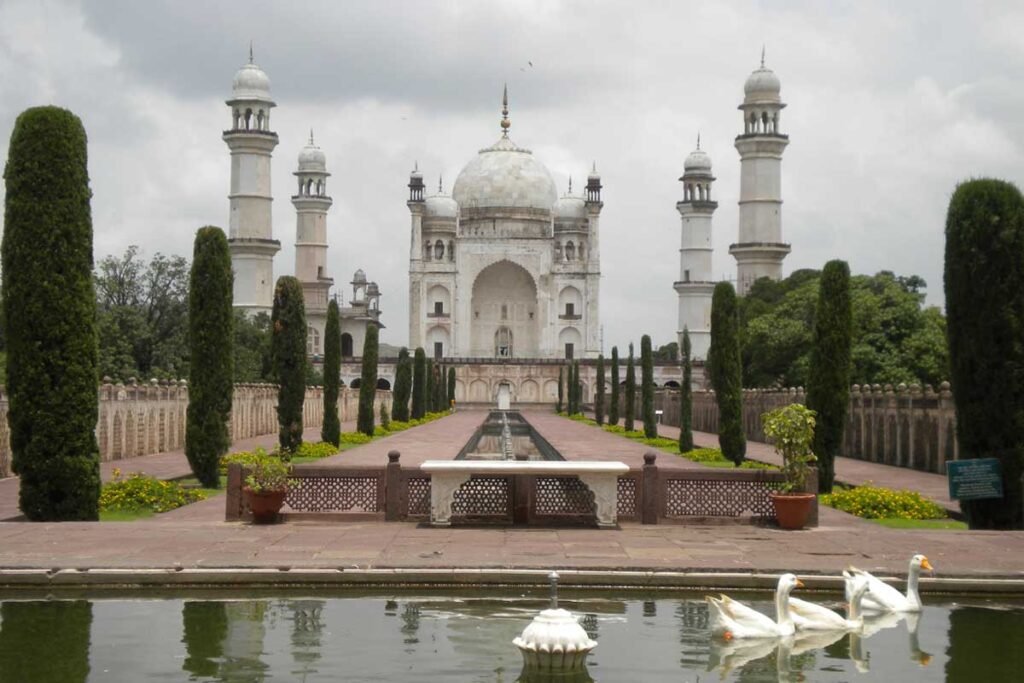
Azam Shah established Bibi Ka Maqbara as a memorial construction for his mother. The grand palace at Aurangabad contains the burial place of Aurangzeb’s wife Rabia Durrani. Bibi Ka Maqbara holds the title Taj Mahal of Marathwada by respectful appreciation.
The construction of the mausoleum which contained the tomb started in 1679 AD through Azam Shah when his father Aurangzeb reigned as Mughal Emperor. The structure incorporates a combination of red and black stones next to marble along with portions of white clay. Stucco Plaster refers to the substance made when red and black stones, marble and white clay are combined. The outer base of the monument features a vast platform which holds Rabia Begum’s burial place in its center. The grave receives protection through marble grids placed on each direction. Through its architectural design the mausoleum receives sunlight throughout daytime while the nighttime moonlight enters through roof windows. The large platform hosts minarets built on each of its four sides. Additionally people could at times enter the minarets.
According to today’s readers, Taj Mahal rules over all expressions of love however ‘Bibi Ka Maqbara’ strengthens their argument because of its position as the most important historical site in Aurangabad. In spite of being smaller than Taj Mahal this historic monument stands to represent Mughal Emperor Aurangzeb’s everlasting love for his wife Dilrasbanu Begum.
The structure stands elevated on a foundation which protects itself with four minarets throughout its corners and visitors can use steps to access three of its sides. When you want to experience all prominent places in Aurangabad this ancient monument stands out with its marble cladding and detailed artworks because of its eternal message of love.
Under the management of the Archaeological Survey of India Bibi Ka Makbara stands as a splendid mausoleum located five kilometers away from Aurangabad railway station. The Archaeological Survey of India maintains Bibi Ka Mukbara while it stands as one of the popular attractions in Aurangabad for visitors.
The monument Bibi-ka-maqbara exists to commemorate Rabia-ul-Daurani alias Dilras Bano Begum who was the spouse of Mughal ruler Aurangzeb. Through his son Prince Azam Shah fired the construction of the mausoleum from 1651 until 1661 AD as a memorial to his mother Begum Rabia Durrani. A couple of years following the death of Aurangzeb the mausoleum was built to imitate Taj Mahal. Among all structures named the Taj this monument stands distinguished as the smaller version of the original Taj Mahal in Agra. The tour package needs to include Aurangabad as one of its essential stops.
The main entrance displays an inscription which states that Ata-Ullah created the design as an architect alongside the engineer Hanspat Rai. The makers retrieved marble from a mine located near Jaipur to construct this mausoleum. The equal ground plan of the mausoleum alongside its nearby environment analogously to the Taj Mahal does not create the same sense of enchantment as the Taj Mahal does. The structure stands as a weak copy of the Taj Mahal according to most experts.
The mausoleum exists in the structured Charbagh formal garden area. Within a massive 458-meter-by-275-meter area a massive mausoleum occupies the center position while high-walled bastion structures occupy intervals and pavilions appear at the three open sides. Four minarets extend from each corner of the raised square platform that supports this structure and steps lead to it from three sides. The addition of a mosque to the western side was done by the Nizam of Hyderabad after the completion of the main structure. The pathway extending from the entrance gate contains fountains installed in the center with gardens covering both sides of the area.
The structure features a prominent central dome while four smaller domes circle it as well. Four small minarets near the main structure and four large minarets at its corners. Marble material was employed in the construction of the mausoleum up to its dado point. Marble elements construct the area above the dado level until the base of the dome where the builders incorporated basaltic trap before finishing this portion with marble. A thin layer of plaster covers the basaltic trap surface before being finished with detailed stucco work and receiving a smooth polished surface. Rabia-ul-Daurani’s remains are located beneath an octagonal marble screen which exquisitely displays beautiful designs through a descending staircase. A low barricaded marble screen decorates the octagonal aperture through which visitors can view the mausoleum floor. People standing at ground level can view the samadhi because of the octagonal opening. The dome above the structure carries decorated panels showing flowers and vine-like plants that act as support elements for the floral decorations.
Every October MTDC arranges a festival to commemorate Bibi Ka Makbara. The archaeological museum positions itself right after the mausoleum and contains exclusive Mughal-era artefacts alongside personal belongings.
Place: Begampura, Aurangabad, Maharashtra 431004
Time : 8 AM to 8 PM
Entry Fee
10. Ellora caves
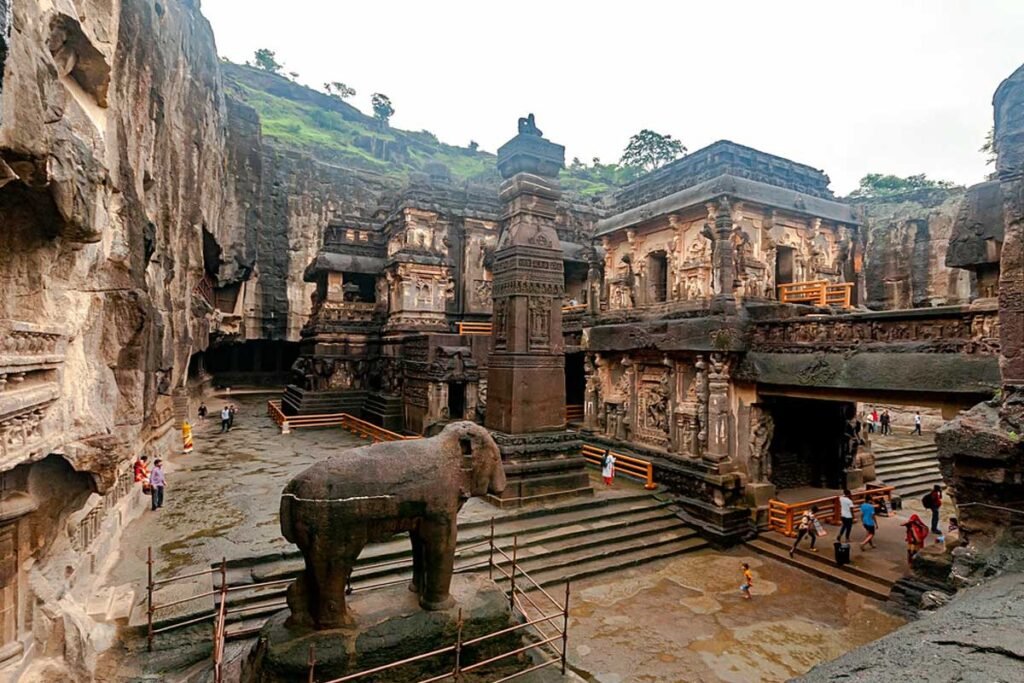
Located about 29 km from Aurangabad stands the yesteryear architectural masterpiece known as the Ellora Caves. This remarkable series of caves sits 29 km from the city center and its construction occurred under the Rashtrakuta clan of Buddhist clan together with the Jain Yadav group. At the top of UNESCO World Heritage Sites in Maharashtra stands this cave series which showcases all accomplishments and established standards from previous Indian cultural times. The caves receive individual numbering because they display complex and detailed carvings. The most renowned and investigated Ellora Cave is number 32 while the others include Vishwakarma among all others and then follow Cave No. 10 with Dashavatar and Cave No. 15 with Kailasanath Temple combined with Cave No. 16 that exhibits Rameswara and lastly Cave No. 21 and Indrasabha. The series of caves presents visitors with past insights and historical variety and architectural greatness and monumental splendor making it a famous Aurangabad tourist location.
The whole mountaintop displays a structure similar to a murti through its external shaping which resembles a Dravidian temple temple. The entire temple spans 276 feet in length while occupying 154 feet in width and resulted from one contiguous rock. The entire structure extends downward from its initial point at the summit. The builders removed about 40 thousand tons of rock stone to construct this venturesome structure. After detaching this first section the structure was constructed the builders began excavating the interior portion to establish the present 90 feet temple. Icons cover all the exterior surfaces of the temple. Both the temple structure and its surrounding terrace were built across three connecting sides as they extended from the temple’s uppermost point. Now this bridge has fallen. The nave of the open pavilion contains Nandi status and massive elephant statues along with pillars. The construction showcases brilliant architectural abilities of India as a nation.
The historical cave site known as Ellora Caves exists 28 km west of Aurangabad in Verul near Aurangabad within 98 km of Ajanta Caves Marking 104 km from Shirdi and 176 km from Nashik and 253 km from Pune until it reaches 344 km from Mumbai. The Indian heritage monument of Ellora draws the greatest number of visitors while serving as a leading destination for tourists in Maharashtra.
These caves receive their local name as ‘Verul Caves’ and UNESCO established them as a World Heritage Site in 1983. Visitors should prioritize visiting Ellora since it stands as an essential tourist destination close to Aurangabad. During the 6th through 10th centuries AD the Charanendri mountain received its cave carvings along its vertical mountainside. The carving age commenced approximately 550 at which period the Ajanta Caves had already been vacated. Tourists can access Kailas Temple (porte 16) as part of an Ellora tour package to experience its remarkable character.
During a period of Buddhist decline in India Hinduism began to reemerge thus the Ellora Caves were created. The Brahmanical movement received substantial strength from Chalukya and Rashtrakuta rulers who regulated temple construction at Ellora before the 8th-century construction of Kailasa temple. The local rulers began constructing during the tenth century before they chose to support the Digambara sect instead of Shaivism.
The Buddhist along with Hindu and Jain temples make up the spectacular cave complex of Ellora Caves. A slightly less dramatic setting than the caves at Ajanta, but more exquisite sculptures. The Charandri rock formations were transformed into 34 caves among which Buddhist sites number 12 while Hindu sites reach 17 and Jain sites amount to 5. The first twelve caves of Ellora hold Buddhist monasteries and chaityas and viharas whereas the temples belonging to the Hindu faith exist within caves 13 through 29. Jain temples within Caves 30 to 34 were constructed at the 9th and 10th centuries. Several religious structures located together within one site demonstrate the high level of religious acceptance that exists in India. Tourists can explore Ellora Caves through packages offered by Aurangabad Holiday Packages.
Among all the structures at the cave group Kailasa Temple stands out as the most remarkable work of art. The single giant rock formation contains the masterpiece Dravidian art within its seven components: entry, square, exhibition area, hall, sanctum and bastion. The architectural Kailasa Temple stands as a beautiful specimen which displays intriguing regional elements along with fabulous stone carvings. Historians conjecture that King Krishna I from the Rashtrakuta dynasty started the construction during the years 756-773.
The Ajantha-Ellora Festival takes place annually in Aurangabad to commemorate both Ellora and Ajintha caves and additional historical landmarks of the area. The grand event welcomes important figures who represent Indian art and culture. The festival shows performers presenting classical as well as folk dances combined with vocal and instrumental music performances. The venue of this festival has transitioned from Kailas temple at Ellora Caves to the historic Golden Mahal palace in Aurangabad.
Hotel Kailas stands alone as the hotel option closest to Ellora Caves because of its opposite location. The establishment provides both cottages and hostels to suit the needs of cost-conscious vacationers. Most touristic activity happens in Aurangabad while tourists explore the distance of 28 km to visit Ellora.
Aurangabad Airport serves as the closest airport which operates 35 kilometers away from Ellora Caves. Aurangabad Railway Station works as the key railway gateway to reach Ellora Caves. Travelers can use public along with private bus routes to reach Ellora Caves from Aurangabad. Private car rentals are available for visitors who start their tour from Aurangabad city. The city of Aurangabad has direct bus connections which serve Pune, Mumbai, Shirdi, Nashik, Hyderabad, Bangalore, Goa and Nagpur.
The recommended visit period for Ellora Caves extends from June through February when October to January constitutes the main tourist season. During the months of June to February it is optimal to travel to Ellora Caves because the climate during that period remains ideal.
Location: Ellora Cave Road, Ellora, Aurangabad, Maharashtra 431005
Time: 6 AM to 6 PM
Entry Fee: Starts from INR 40
related articles : Top 10 Best Places to Visit in Chandrapur for Nature, History & Spirituality
Stay Informed With the Latest & Most Important News
Previous Post
Next Post
-
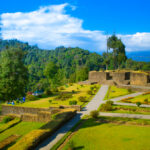 01Top 5 Best Places Visiting in Gyalshing – Monasteries, Lakes & Scenic Escapes
01Top 5 Best Places Visiting in Gyalshing – Monasteries, Lakes & Scenic Escapes -
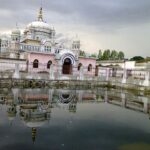 02Top 5 Best Places Visiting in Panna – Temples, Waterfalls & Wildlife Escapes
02Top 5 Best Places Visiting in Panna – Temples, Waterfalls & Wildlife Escapes -
 03Top 5 Best Places to Visit in Malerkotla – Malerkotla Fort, Sheesh Mahal & More
03Top 5 Best Places to Visit in Malerkotla – Malerkotla Fort, Sheesh Mahal & More -
 04Top 10 Best Places Visiting in Dakshina Kannad for Culture, Nature & Coastal Charm
04Top 10 Best Places Visiting in Dakshina Kannad for Culture, Nature & Coastal Charm -
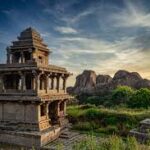 05Top 2 Best Places Visiting in Chitradurga for History, Nature & Adventure
05Top 2 Best Places Visiting in Chitradurga for History, Nature & Adventure -
 06Best Places Visiting in Shopian – Explore Top Attractions & Hidden Gems
06Best Places Visiting in Shopian – Explore Top Attractions & Hidden Gems -
 07Best Places Visiting in Narmadapuram – Temples, Waterfalls & Wildlife Escapes
07Best Places Visiting in Narmadapuram – Temples, Waterfalls & Wildlife Escapes












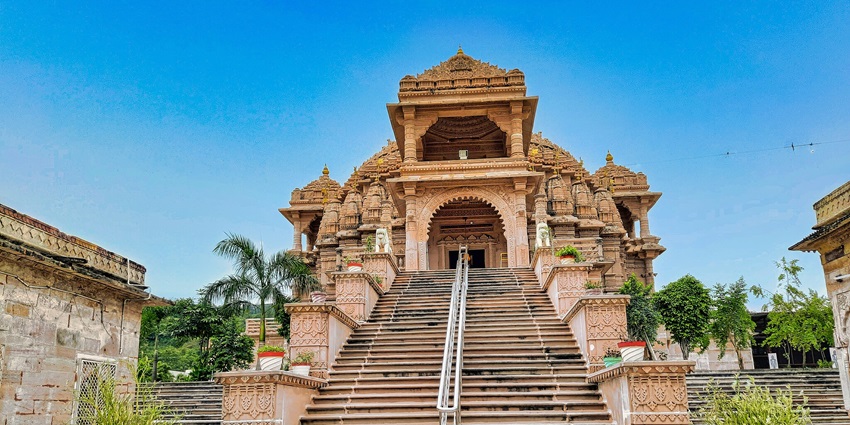

Pingback: Top 10 Best Places to Visit in Gadchiroli – Complete Travel Guide